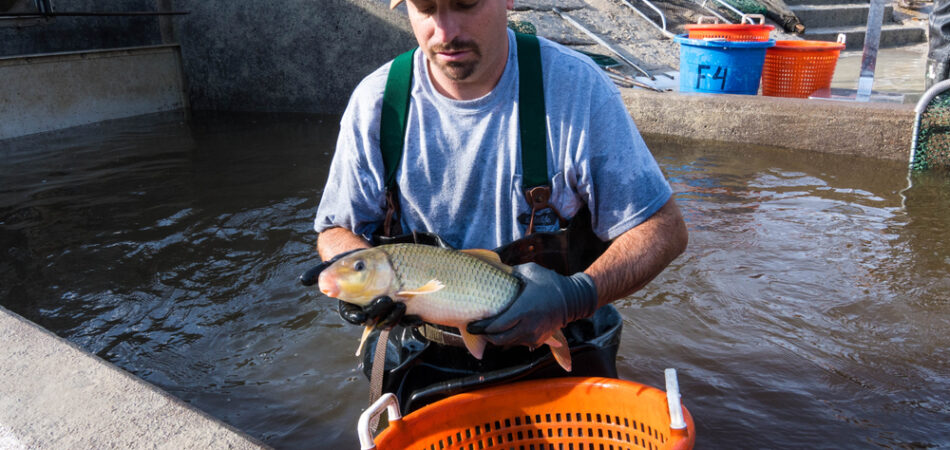
Fish stocking plays a crucial role in maintaining ecological balance, supporting recreational fishing, and even bolstering local economies. Whether you’re considering pond stocking fish for sale in Pearl River County, MS, or in Lumberton, MS, understanding the science behind this practice is vital for achieving sustainable outcomes. This blog delves into the scientific principles of fish stocking, exploring population dynamics and the broader implications for ecosystem health.
What Is Fish Stocking?
Fish stocking is the practice of introducing fish species into various water bodies, such as ponds, lakes, and rivers. This method is often employed to:
- Enhance recreational fishing opportunities.
- Restore populations of native fish species.
- Manage aquatic ecosystems for ecological balance.
- Support aquaculture and commercial fishing operations.
Fish stocking isn’t as simple as introducing fish into water. It requires careful planning, knowledge of the aquatic environment, and an understanding of the ecological and biological factors that influence fish populations.
Key Factors in Fish Stocking
Species Selection
Choosing the right species is a critical step in fish stocking. Factors that influence species selection include:
- Water Quality: Certain fish species thrive in specific temperature ranges, oxygen levels, and pH conditions.
- Ecosystem Compatibility: Introducing non-native species can disrupt existing ecosystems, so careful consideration is required.
- Purpose: Whether the goal is recreational fishing, biodiversity restoration, or commercial production, species should align with the intended purpose.
For example, those involved in pond stocking fish for sale in Pearl River County, MS, often select bass, bluegill, or catfish due to their suitability for local water conditions.
Population Density
Overstocking or understocking can have negative consequences. Overstocking can lead to competition for resources, stunted growth, and water quality issues. Understocking, on the other hand, may result in insufficient population sizes for ecosystem sustainability or fishing purposes.
Stocking guidelines typically recommend:
- Assessing the size and depth of the water body.
- Evaluating available food resources.
- Considering the balance between predator and prey species.
Timing and Frequency
The timing of fish stocking depends on the life cycles of the species and environmental conditions. Stocking during cooler months, such as spring or fall, often improves survival rates due to optimal water temperatures and reduced predation pressures.
Understanding Population Dynamics
Population dynamics refer to the changes in fish populations over time, influenced by factors like birth rates, death rates, immigration, and emigration. In fish stocking, understanding these dynamics is essential to:
- Prevent overpopulation or population crashes.
- Maintain genetic diversity.
- Support sustainable harvesting practices.
Growth Rates and Carrying Capacity
The growth rate of fish populations is influenced by factors such as food availability, water quality, and competition. Carrying capacity—the maximum population size an environment can sustain—is a critical concept in stocking decisions. Exceeding the carrying capacity can:
- Deplete oxygen levels.
- Lead to algal blooms and water quality degradation.
- Cause stress and disease outbreaks among fish.
Predator-Prey Relationships
A balanced predator-prey relationship is essential for healthy aquatic ecosystems. For instance, introducing too many predator fish, such as largemouth bass, without sufficient prey fish like bluegill, can lead to imbalances that destabilize the ecosystem. Careful monitoring and adjustments to stocking plans help maintain this balance.
Ecosystem Health and Fish Stocking
Fish stocking doesn’t occur in isolation; it significantly impacts the broader ecosystem. Maintaining ecosystem health requires a holistic approach that considers:
- Interactions among aquatic species.
- Water quality and habitat conditions.
- The presence of invasive species.
Enhancing Biodiversity
Stocking can enhance biodiversity by introducing native species that have declined due to habitat loss, overfishing, or other factors. Restoring these populations contributes to:
- Improved water quality.
- Greater ecosystem resilience.
- Enhanced recreational opportunities.
For example, pond stocking fish for sale in Lumberton, MS, often includes efforts to reintroduce species that support local biodiversity while also catering to anglers.
Mitigating Invasive Species
Invasive species are a major threat to aquatic ecosystems. Fish stocking programs must ensure that introduced species do not outcompete or harm native species. This involves rigorous screening and adherence to state and federal guidelines.
Steps to Successful Fish Stocking
Conducting a Pond Assessment
Before stocking fish, a thorough assessment of the pond or water body is essential. This includes:
- Measuring Water Parameters: Assess temperature, pH, dissolved oxygen, and nutrient levels.
- Evaluating Habitat: Determine the availability of shelter, spawning areas, and vegetation.
- Identifying Existing Species: Avoid conflicts between newly stocked fish and existing populations.
Developing a Stocking Plan
A stocking plan outlines the species, numbers, and timing of fish introductions. Collaborating with experts or local agencies can ensure compliance with regulations and alignment with ecological goals.
Monitoring and Maintenance
Post-stocking monitoring is crucial for evaluating the success of the program. Regular assessments should focus on:
- Population health and growth rates.
- Water quality changes.
- Signs of disease or ecological imbalance.
Maintenance activities, such as aeration, vegetation management, and supplemental feeding, can support the long-term success of fish stocking initiatives.
Economic and Recreational Benefits
Fish stocking has far-reaching economic and recreational benefits. For communities in Pearl River County, MS, and Lumberton, MS, these benefits include:
- Boosting Local Economies: Stocked ponds attract anglers, creating demand for related businesses like bait shops, fishing gear, and guided tours.
- Enhancing Property Value: Well-stocked ponds increase the appeal and value of residential and commercial properties.
- Promoting Outdoor Recreation: Fishing provides a wholesome outdoor activity that fosters community engagement and appreciation for nature.
Challenges and Ethical Considerations
Despite its benefits, fish stocking comes with challenges and ethical responsibilities. These include:
- Ecological Risks: Improper stocking can harm native species and disrupt ecosystems.
- Genetic Concerns: Stocking hatchery-raised fish may dilute the genetic diversity of wild populations.
- Animal Welfare: Ensuring humane handling and transportation practices minimizes stress and mortality among stocked fish.
Advancements in Fish Stocking Science
Recent advancements in fish stocking science are helping to address these challenges. Innovations include:
- Genetic Screening: Advanced techniques ensure stocked fish maintain genetic diversity and compatibility with native populations.
- Eco-Friendly Practices: Sustainable aquaculture methods reduce environmental impacts.
- Technology Integration: Tools like GIS mapping and population modeling improve stocking strategies.
Conclusion
The science behind fish stocking is complex but essential for achieving ecological, economic, and recreational goals. For those engaged in pond stocking fish for sale in Pearl River County, MS, or Lumberton, MS, understanding population dynamics and ecosystem health is key to successful and sustainable practices.
By prioritizing careful planning, ongoing monitoring, and adherence to ecological principles, fish stocking can enhance aquatic ecosystems while supporting human needs. Whether you’re a pond owner, a recreational angler, or a conservationist, embracing the science behind fish stocking ensures a brighter future for our water resources.
Visit us in Lumberton, MS
Established in 1991, we here at Slade’s Fish Hatchery are a family-owned and ran fish hatchery located in Lumberton, Mississippi. We are raisers and distributors of catfish and other game fish, including bass, bream, catfish, tilapia, and grass carp, along with goldfish and koi fish. By controlling the environment, nutrition, breeding, and life cycle, our hatchery has improved the quality and productivity of these fishing for stocking in ponds or use as bait. In addition to our pond stocking and fish sales, we also provide consultation on pond management and maintenance. We frequently serve the Mississippi coast but also will travel for a fee of $2 per mile through Mississippi, Louisiana, and Alabama. Give us a call or drop by today!
